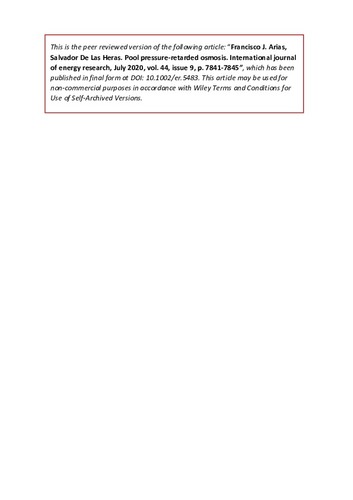Pool pressure-retarded osmosis

Visualitza/Obre
Cita com:
hdl:2117/327344
Tipus de documentArticle
Data publicació2020-04-23
Condicions d'accésAccés obert
Tots els drets reservats. Aquesta obra està protegida pels drets de propietat intel·lectual i
industrial corresponents. Sense perjudici de les exempcions legals existents, queda prohibida la seva
reproducció, distribució, comunicació pública o transformació sense l'autorització del titular dels drets
Abstract
In this work, consideration is given for pressure-retarded osmosis (PRO) system in a pool configuration. The motivation behind of such a configuration lies in the possibility to eliminate mechanical moving parts or energy recovery systems—as for example pressure exchangers (PEXs), which are needed in traditional PRO systems. In a pool configuration mobile parts as pumps or PEXs may no longer be needed because advantage is taken not only in the osmotic energy released upon the mixing of the two solutions with different concentrations but also in the buoyant potential from the gradient of density. The preliminary mathematical development for a pool configuration constitutes the core of this work. The main theoretical difficult which aroused when attempting to analyze a pool-PRO system was the determination of the vertical motion of the plume formed immediately after the detachment and the mixing which must be at least equal than that given by the water permeability coefficient of the membrane if it is desired that the system works in a steady stay. Because hydrodynamic entrainment induced by the vertical motion of the plume must be promoted in order to replenish with fresh draw solution the membrane, then it must be arranged in clusters which from computational fluid dynamics (CFD) simulations performed should be in the range of 50 to 100µm
CitacióArias, F.J.; De Las Heras, S.A. Pool pressure-retarded osmosis. "International journal of energy research", 23 Abril 2020, vol. 44, núm. 9, p. 7841-7845.
ISSN0363-907X
Versió de l'editorhttps://onlinelibrary.wiley.com/doi/abs/10.1002/er.5483
| Fitxers | Descripció | Mida | Format | Visualitza |
|---|---|---|---|---|
| Arias, Francisc ... ssure-retarded osmosis.pdf | 1,171Mb | Visualitza/Obre |

